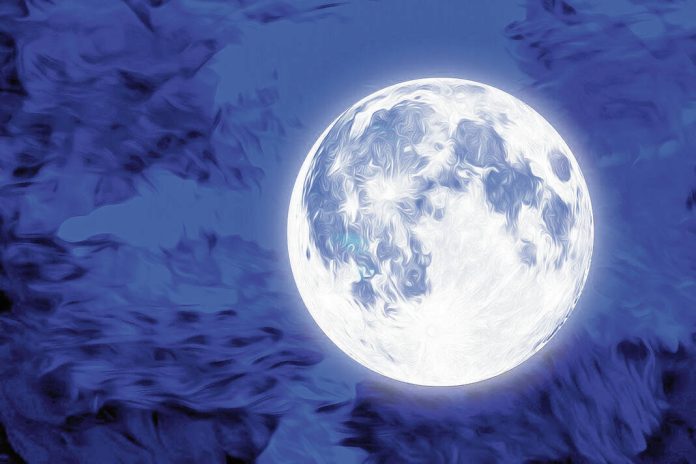
A full moon, supermoon and a blue moon will take place Wednesday night.
Submitted photo
“Once in a blue moon” refers to an event that happens rarely and infrequently, according to dictionary.cambridge.org.
That term applies to Wednesday’s nighttime sky, as the full moon will be a supermoon, a blue moon and Rakhi Purnima. Also, the planet Saturn is just a few days from its closest and brightest of the year, according to solarsystem.nasa.gov.
Saturn will appear near the moon as twilight ends 5 degrees to the upper right of the moon and will seem to swing clockwise around the moon as the evening progresses. The moon will appear full for three days around the peak of the full moon, from Tuesday night to Friday morning.
Will the moon actually be blue? No, that’s just the term for two full moons in a month. However, on rare occasions, tiny particles in the air ― typically of smoke or dust ― can scatter away red wavelengths of light, causing the moon to appear blue, according to moon.nasa.gov.
While skygazers probably won’t notice a big difference in the size of the moon, a supermoon appears about 14% larger because the moon is closer to Earth. This can be compared to the difference in size between a quarter and a nickel, and because the moon will be close to us, it will appear brighter than normal.
This particular full moon also is significant in the Hindu tradition as it coincides with the festival of Raksha Bandhan, also known as Rakhi or Rakhi Purnima. During this festival, sisters tie a rakhi, a cotton bracelet, around their brothers’ wrists as a symbol of their bond and protection. In return, brothers offer a gift to their sisters, according to ts2.space.
The npr.org website states the moon will seem extra big and bright and should be quite a sight to behold, and the blue supermoon won’t happen again until 2032.
Blue moon also is used to describe the third of four full moons in an astrological season. The moon takes 27.3 days to orbit the Earth, but because of how the sun’s light hits the satellite, it takes 29.5 days to complete its lunar cycle from one new moon to the next.
Over the nights following Wednesday, the moon will rise around an hour later each day, becoming prominent later in the night. Within a few days, it will only be visible in the predawn and early morning sky. By the time it reaches last quarter, a week after full moon, it will rise in the middle of the night and set at around noon, according to in-the-sky.org.
As summer evolves into fall, the daily periods of sunlight will shorten gradually. Then the autumn equinox will occur Sept. 23, symbolizing the start of the fall season.
NASA has a daily moon guide online, moon.nasa.gov/moon-observation/daily-moon-guide, for observing the moon year-round. Those who miss this week’s special celestial event will have to wait nine years for their next chance.
